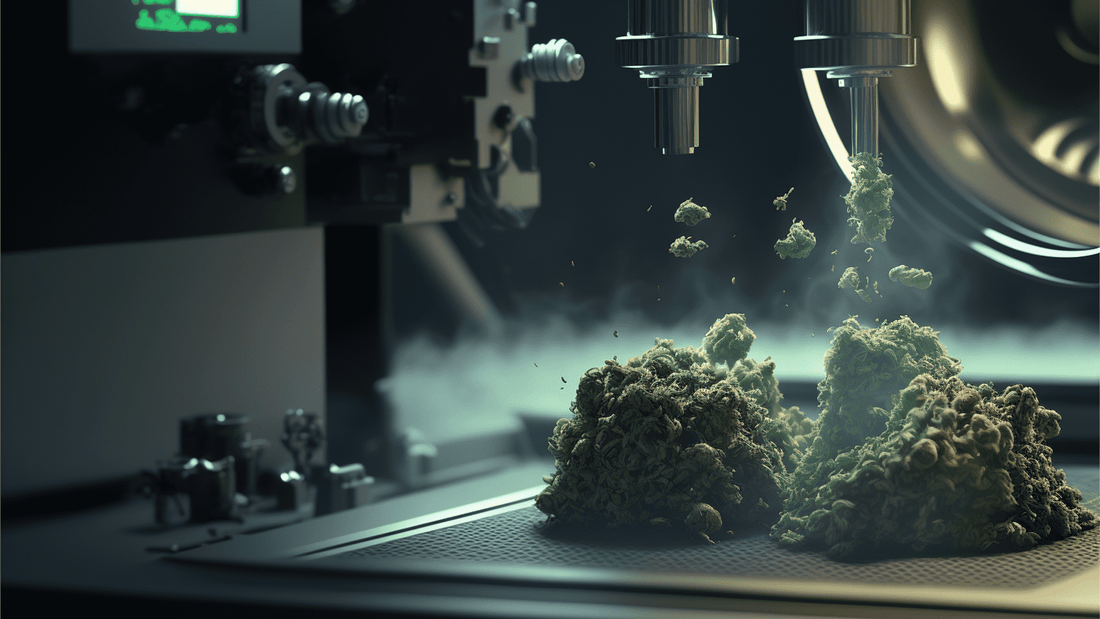The world of weed is vast and varied, with different strains offering unique flavours, aromas, and effects. From sativas to indicas to hybrids, there's a strain for every cannabis enthusiast. But how are these strains created, and what makes them unique?
In this article, we'll take a deep dive into the world of weed breeding and explore the history and science behind creating new cannabis strains. We'll also discuss the various factors that go into creating the perfect strain, from genetics to cultivation techniques.
So sit back, relax, and get ready to learn all about the fascinating world of weed strain creation!
Breeding

The cannabis plant is unique because it is dioecious, meaning it can be either female or male. Female cannabis plants produce prized buds for their psychoactive and medicinal properties, while male plants produce pollen sacs that release pollen when they mature.
When a male plant releases its pollen, it can be carried by the wind to a nearby female plant, which can then become pollinated. If a female plant is pollinated, it will grow seeds with buds that carry the genetics of both female and male plants. When these seeds grow into new plants, they will be a new strain that combines traits from both the male and female parent plants.
In the wild, cannabis plants can breed naturally when males and females grow near each other. When a female plant matures and dies, its seeds will fall to the ground and grow into plants of the new strain the following year.
Breeding cannabis strains is not a simple process; it requires a deep understanding of genetics and plant biology. First, breeders must carefully select parent plants with specific traits and then cross them to create new strains. This process can take many years and can involve hundreds of plants before a desirable new strain is created.
Through breeding, cannabis cultivators and breeders have created various strains with various flavours, aromas, and effects. From classic strains like Blue Dream and Sour Diesel to newer, innovative strains like Gelato and Lemon Tree, the world of cannabis is constantly evolving thanks to the art and science of breeding.
How Hybrid Weed Strains Are Made?

First, you'll need to decide on the parent strains you want to use. This will involve selecting strains with specific traits you'd like to combine, such as taste, aroma, potency, effects, yield, and ease of growing. Next, you'll need to choose one female plant and one male plant, each from a different strain.
Once your parent plants are selected, you'll need to ensure successful pollination. In a commercial setting, this is often done in a closed room called a breeding chamber, where the male and female plants are placed together. This helps to contain the pollen and prevent it from reaching other strains. Alternatively, you can also pollinate plants outdoors by keeping them close together and ensuring no different strains release pollen.
Once the female plant is pollinated and grows to maturity, you'll need to collect its seeds. These seeds will be used to develop new plants that contain the genes of both the female and male parent plants. These unique plants are referred to as a cross or a hybrid of the parent strains.
Creating a hybrid cannabis strain is a complex process that requires careful planning and attention to detail. But with the right approach and a little luck, you can create a unique strain that combines the traits of its parent strains in a way that may be more desirable than either one on its own.
Phenotypes

The physical traits of a cannabis plant are all influenced by its genetics and environment. For example, a plant with a genotype that predisposes it to be tall and lanky may grow differently depending on whether it is grown in a warm or cool climate. Similarly, a plant with genetics that makes it more susceptible to producing high levels of resin may have different resin production depending on the nutrients it receives during cultivation.
Just like puppies in a litter may have different physical traits based on the genetics of their parents, cannabis phenotypes will express different characteristics based on the genetics of their parent strains. For example, some phenotypes may be tall and lanky like one parent strain, while others may be shorter and more densely packed with trichomes like the other parent strain. Some may have a mix of traits from both parents, and all of the phenotypes will be unique in the combination of features they inherit.
Understanding and identifying different cannabis phenotypes is vital for cultivators and breeders because it allows them to select the plants with the most desirable traits for breeding or cultivation. By carefully selecting and breeding plants with specific characteristics, cultivators and breeders can create new strains tailored to meet consumers' needs and preferences.
Pheno-hunting?

The process of pheno-hunting involves carefully evaluating each phenotype for traits such as flavour, aroma, potency, yield, and overall appearance. Some phenotypes may excel in certain areas but not others, so the breeder must decide which combination of traits is the most desirable for the new strain.
Pheno-hunting often takes several generations to identify the best expression of a new strain. For example, a breeder might start by growing ten seeds into plants and selecting the five with the most desirable traits. These five plants will be grown again and whittled down to three, then those three will be grown and whittled down to the final phenotype. This process can take months or even years, as each cultivation cycle takes time.
Once the breeder has identified the phenotype with the best combination of traits, they will mass produce it and bring it to market. This is the version of the new strain that will be available for purchase at dispensaries. Pheno-hunting is critical in creating a new cannabis strain, as it ensures that only the best plants are brought to market and sold to consumers.
New Phenotypes Of Established Strains?

For example, if the original Gelato strain becomes popular and is in high demand, a breeder might pheno-hunt for other phenotypes of Gelato that have different combinations of traits. One of these phenotypes, Gelato #33, might have a particularly desirable flavour or aroma. The breeder could mass produce it and bring it to market as a "spin-off" of the original Gelato strain.
While these two versions of Gelato are similar in that they share the same parent strains, they are also unique in the combination of traits they inherit from those parent strains. This can result in different flavours, aromas, and overall effects, even though they are part of the same strain family.
By bringing out new phenotypes of existing strains, breeders can offer consumers a wider variety of options and allow them to experience different expressions of the same strain. This can also help to keep the market fresh and exciting, as new phenotypes can offer a new twist on a classic strain.

 4.7 Rating. Excellent.
4.7 Rating. Excellent.






